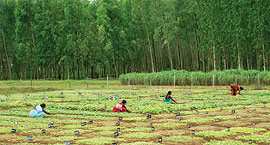 We
continued to enlarge our farm and social forestry programmes
and added nearly 15,000 hectares of plantations in 2007-08.
The total farm and social forestry plantations, as at March
31, 2008, covered an area of over 80,000 hectares. We
continued to enlarge our farm and social forestry programmes
and added nearly 15,000 hectares of plantations in 2007-08.
The total farm and social forestry plantations, as at March
31, 2008, covered an area of over 80,000 hectares.
Apart from providing sustainable source
of raw materials for our Paperboards business and providing
35 million man days of employment to marginal sections of
society, these plantations sequestered 2638 kilotonnes of CO2,
thereby consolidating our 'Carbon Positive' status for the
third successive year.
Higher CO2 emission in 2007-08
were due to significant growth in almost all the businesses,
large scale project activities and inclusion of 4 subsidiary
companies’ performance in this Report.
|

